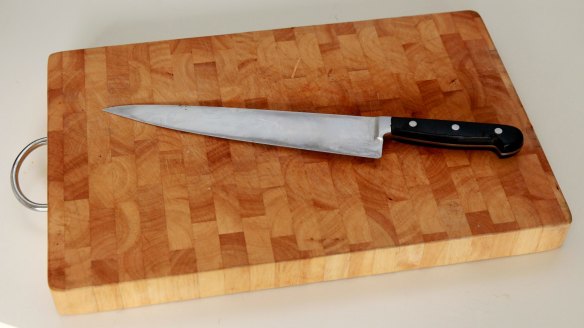Why you should think big when you buy a cutting board

In the food world, there's an inclination to label this equipment or that ingredient as a must-have. (Food media types such as myself: guilty.) If the ordinary home cook had every one of these must-haves, well, there wouldn't be room for anything else in the house.
But you should really own a large wooden cutting board.
A second wooden one, and another in plastic, is helpful, too.
Food isn't necessarily small, and your board shouldn't be, either.
As with a chef's knife, there will hardly be a dish that comes out of your kitchen that doesn't require at least one cutting board.
Think big for safety reasons. The last thing you want is a crowded workspace. If you don't give yourself plenty of room, you're more likely to injure yourself with a knife when food starts piling up - try to keep your board as clear as possible in general - and you adjust your slicing motion or hands in awkward ways. Plus, who wants to be chasing food all over the counter? A larger wooden board - about 35 by 50 centimetres - is also likely to be a bit heavier, so it won't slide around as easily. (Put a wet paper towel or piece of shelf liner under the board if it has a tendency to move on you.)
Also, sometimes you're just going to have to cut or carve something large. Think about a pumpkin, or your Thanksgiving turkey. Even some long celery ribs. Food isn't necessarily small, and your board shouldn't be, either.
Wood is better for your knives. Plates and counters are not kind to your blades, which can be dulled on such hard surfaces. Wood and plastic are durable enough to withstand abuse while not affecting the knives. You can wash your wooden board in hot soapy water (just don't let it soak), but apply a layer of mineral oil every so often to keep it from drying out and from absorbing moisture from whatever you're cutting.
A wooden board can serve multiple uses in your kitchen. You've got a built-in serving platter, whether it's for the crudites you just cut on it or a few wedges of cheese. Even a sliced loaf of bread can look that much better on a board. A large board placed over the sink can also serve as auxiliary counter space when you're cooking and run out of room to put ingredients or tools. Leaning up against a wall, a beautiful wooden board also just looks good.
An extra board helps prevent cross-contamination. Research done by the University of California, Davis, shows that wooden cutting boards are good at trapping potentially harmful bacteria, eventually causing them to die; plastic boards, especially those with lots of knife scars, can harbor and spread the bacteria.
Still, you don't want to immediately put other ingredients - and definitely not ones you won't be cooking - on the same surface as where your raw meat just sat. If you think you'll often find yourself in that situation, consider a second board you reserve just for meat. You can make that one plastic, as long as you put it through the dishwasher, which the UC-Davis researchers found was effective at killing bacteria on plastic, unlike washing by hand. But be sure to manually wash your wooden boards.
And while you can certainly spend a lot of money on artisan boards, a large wooden workhorse doesn't have to cost a lot. (Plastic boards are even cheaper.) You can find reasonably priced ones online that are made of teak, which can stand up to your knives and resists water (the sourcing can be controversial, so try to look for items from sustainable teak plantations). With proper care, it will give you years of use and great meals.
The Washington Post
The best recipes from Australia's leading chefs straight to your inbox.
Sign up- More:
- Home and design